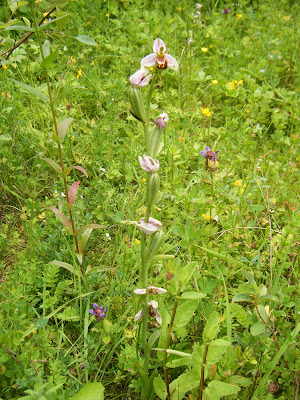Diabetes mellitus, commonly referred to as just diabetes, is a metabolic disease resulting from defects in insulin metabolism. This may be due to an inability of ones own pancreas to produce enough insulin or if a body cannot utilise insulin that is produced effectively. Since insulin controls blood sugar levels, this results in chronic hyperglycemia (heightened blood sugar levels) in individuals which leads to long-term damage of, but not limited to, the body's nervous and circulatory systems. With the WHO estimating that 3.4 million people died in 2004 alone of diabetes and that some 346 million people worldwide have the disease, it is recognised as a serious global health issue (1).
 |
| Common Centaury, Centaurium erythraea |
One of the complications associated with diabetes is the increased production of free radicals, such as reactive oxygen species, due to hyperglycemia (2). These unstable radicals react with lipids, proteins and DNA in cells, producing cellular changes and abnormal function. It has been proposed that phytochemicals could be a valuable source of compounds that could be used to control free radical concentrations (3). One such source is from the pretty but unassuming annual flower Common Centaury (Centaurium erythraea). At this time of the year, its pink flowers are in bloom in dry grassy places, sand dunes and waste places (the plants pictured were seen in an abandoned quarry) (4). Though capable of growing to 50 cm, it rarely reaches more that 15 cm in height and is widespread throughout much of Europe, western Asia and North Africa with several chemotypes described (5). It is also present in North America and Australia as an introduced alien.
 |
| Common Centaury, Centaurium erythraea |
C. erythraea is commonly used in traditional medicine as a purgative, sedative, to relieve indigestion and to relieve indigestion and to treat jaundice, wounds and sores (2). It has also been shown to have antioxidant properties, and with this in mind, rats that had diabetes induced experimentally were treated with extract of C. erythraea leaves by researchers in Tunisia and Morocco (2). It was shown that oxidative stress and pancreatic cell damage decreased in those animals treated with the leaf extract. Indeed, that pancreatic β cells of diabetic animals treated with C. erythraea showed nearly normal morphology after treatment. While the exact molecular mechanism of action remains unclear, such results are promising in the global battle against diabetes.
References:
- http://www.who.int/mediacentre/factsheets/fs312/en/index.html
- Sefi et al., 2011. Journal of Ethnopharmacology 135 pp. 243-250
- Eddouks et al., 2005. Journal of Ethnopharmacology 102 pp. 228-232
- Phillips, 1977. Wild Flowers of Britain p. 116
- Šiler et al., 2012. Industrial Crops and Products 40 pp. 336-344












